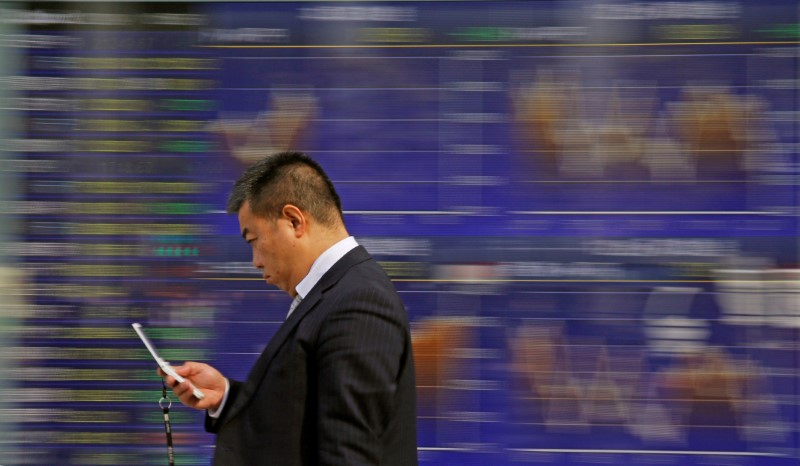
FILE PHOTO: A man walks past an electronic stock quotation board outside a brokerage in Tokyo, Japan, February 9, 2018. REUTERS/Toru Hanai
June 18, 2018
By Hideyuki Sano and Swati Pandey
TOKYO/SYDNEY (Reuters) – Asian shares fell to a 2-1/2 week low on Monday after U.S. President Donald Trump cranked up trade tensions by going ahead with tariffs on Chinese imports, prompting Beijing to immediately respond in kind.
Fears of a global trade war added to pressure on oil prices, which extended Friday’s big fall, while the dollar retreated from near 3-week highs against the safe haven yen <JPY=>.
Spreadbetters suggested a subdued start for European shares, with FTSE futures <FF1c1> off about 0.1 percent. U.S. E-Mini S&P futures <ESc1> stumbled 0.5 percent, suggesting a weaker start on Wall Street.
MSCI’s broadest index of Asia-Pacific shares outside Japan <.MIAPJ0000PUS> slid 0.5 percent to its lowest level since May 31.
Financial markets in China and Hong Kong were closed for Dragon Boat festival holiday.
Japan’s Nikkei <.N225> sank 0.8 percent as worries over growing protectionism overshadowed stronger-than-expected export data.
“The on-again off-again possible global trade war is looking to be back on again as the U.S. and China announced tariffs on each other’s imports,” said Nick Twidale, Sydney-based analyst at Rakuten Securities Australia.
“This looks set to be the main theme that investors will focus on…with any further escalation in tension adding to the downside risk.”
Trump announced hefty tariffs on $50 billion of Chinese imports on Friday, laying out a list of more than 800 strategically important imports from China that would be subject to a 25 percent tariff starting on July 6, including cars.
China said it would respond with tariffs “of the same scale and strength” and that any previous trade deals with Trump were “invalid.” The official Xinhua news agency said China would impose 25 percent tariffs on 659 U.S. products, ranging from soybeans and autos to seafood.
China’s retaliation list was increased more than six-fold from a version released in April, but the value was kept at $50 billion, as some high-value items such as commercial aircraft were deleted.
However, many market watchers believe there is still room for compromise, suspecting Trump’s announcement was a negotiating tactic to wring faster concessions from Beijing.
“Ultimately, a negotiated solution is likely – and this is what both the U.S. and China want – but the risks are high and the tariffs could well be implemented before the issue is resolved,” said Shane Oliver, Sydney-based chief economist at AMP.
LIMITED IMPACT?
Analysts say the direct impact of the tariffs may be limited, especially for the U.S. economy, which is in strong shape.
But Asia’s other trade-reliant economies and companies plugged into China’s supply chains are worried they will suffer collateral damage if world trade slows down, hurting global growth and dampening business confidence.
Shares of Japanese construction equipment makers Komatsu Ltd <6301.T> and Hitachi Construction Machinery <6305.T> tumbled 3.9 percent and 2.8 percent, respectively. Both are vulnerable to any downturns in Chinese and global capital spending.
“There are trade frictions not only between the U.S. and China but also between the U.S. and its allies. Trump could put more pressure on other countries like Japan and NATO courtiers,” said Yoshinori Shigemi, global market strategist at JPMorgan Asset Management in Tokyo.
“So far investors have been escaping to high-tech shares and small cap shares. After all, money is still abundant. But investors should be cautious.”
In the currency market, the dollar eased to 110.33 yen <JPY=>, having hit a three-week high of 110.905 on Friday.
The euro traded at $1.1597 <EUR=>, not far from a recent two-week low of $1.1543 after the European Central Bank suggested it would hold off raising interest rates through the summer of next year.
The Australian dollar <AUD=D4>, a liquid hedge for risk, slipped to a six-week trough while its New Zealand cousin <NZD=D4> fell to the lowest since end-May.
Oil prices were under pressure as China’s retaliatory tariffs included U.S. crude oil. [O/R]
U.S. crude futures <CLc1> dropped 1.6 percent to $63.99 per barrel, briefly touching their lowest levels since April 10.
Brent <LCOc1> fell 0.7 percent to $72.93 in response to reports that top suppliers Saudi Arabia and Russia would likely increase production.
(Editing by Kim Coghill)

